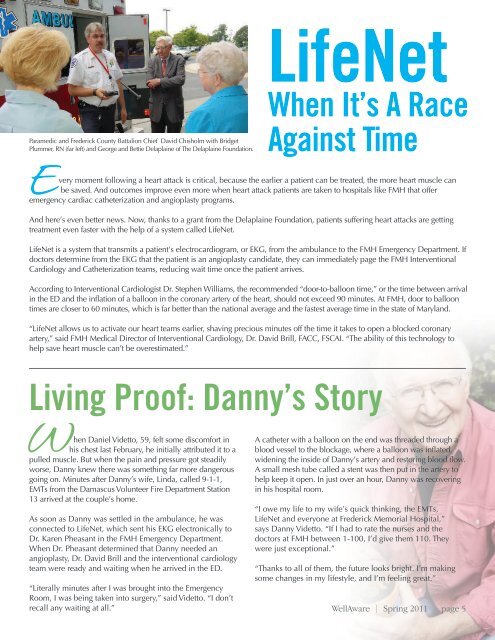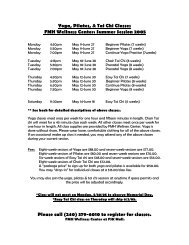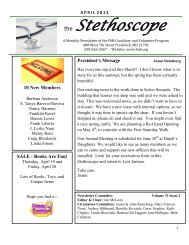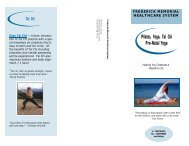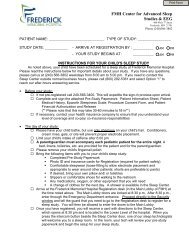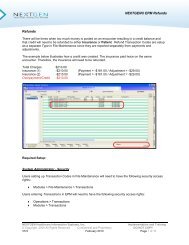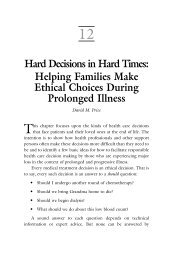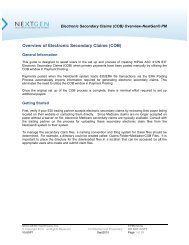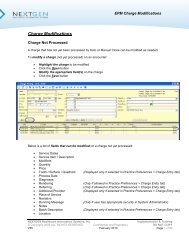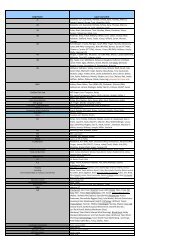Spring 2011: FMH Emergency Services - Frederick Memorial Hospital
Spring 2011: FMH Emergency Services - Frederick Memorial Hospital
Spring 2011: FMH Emergency Services - Frederick Memorial Hospital
You also want an ePaper? Increase the reach of your titles
YUMPU automatically turns print PDFs into web optimized ePapers that Google loves.
Paramedic and <strong>Frederick</strong> County Battalion Chief David Chisholm with Bridget<br />
Plummer, RN (far left) and George and Bettie Delaplaine of The Delaplaine Foundation.<br />
E<br />
very moment following a heart attack is critical, because the earlier a patient can be treated, the more heart muscle can<br />
be saved. And outcomes improve even more when heart attack patients are taken to hospitals like <strong>FMH</strong> that offer<br />
emergency cardiac catheterization and angioplasty programs.<br />
And here’s even better news. Now, thanks to a grant from the Delaplaine Foundation, patients suffering heart attacks are getting<br />
treatment even faster with the help of a system called LifeNet.<br />
LifeNet is a system that transmits a patient’s electrocardiogram, or EKG, from the ambulance to the <strong>FMH</strong> <strong>Emergency</strong> Department. If<br />
doctors determine from the EKG that the patient is an angioplasty candidate, they can immediately page the <strong>FMH</strong> Interventional<br />
Cardiology and Catheterization teams, reducing wait time once the patient arrives.<br />
According to Interventional Cardiologist Dr. Stephen Williams, the recommended “door-to-balloon time,” or the time between arrival<br />
in the ED and the inflation of a balloon in the coronary artery of the heart, should not exceed 90 minutes. At <strong>FMH</strong>, door to balloon<br />
times are closer to 60 minutes, which is far better than the national average and the fastest average time in the state of Maryland.<br />
“LifeNet allows us to activate our heart teams earlier, shaving precious minutes off the time it takes to open a blocked coronary<br />
artery,” said <strong>FMH</strong> Medical Director of Interventional Cardiology, Dr. David Brill, FACC, FSCAI. “The ability of this technology to<br />
help save heart muscle can’t be overestimated.”<br />
When Daniel Videtto, 59, felt some discomfort in<br />
his chest last February, he initially attributed it to a<br />
pulled muscle. But when the pain and pressure got steadily<br />
worse, Danny knew there was something far more dangerous<br />
going on. Minutes after Danny’s wife, Linda, called 9-1-1,<br />
EMTs from the Damascus Volunteer Fire Department Station<br />
13 arrived at the couple’s home.<br />
As soon as Danny was settled in the ambulance, he was<br />
connected to LifeNet, which sent his EKG electronically to<br />
Dr. Karen Pheasant in the <strong>FMH</strong> <strong>Emergency</strong> Department.<br />
When Dr. Pheasant determined that Danny needed an<br />
angioplasty, Dr. David Brill and the interventional cardiology<br />
team were ready and waiting when he arrived in the ED.<br />
“Literally minutes after I was brought into the <strong>Emergency</strong><br />
Room, I was being taken into surgery,” said Videtto. “I don’t<br />
recall any waiting at all.”<br />
LifeNet<br />
When It’s A Race<br />
Against Time<br />
Living Proof: Danny’s Story<br />
A catheter with a balloon on the end was threaded through a<br />
blood vessel to the blockage, where a balloon was inflated,<br />
widening the inside of Danny’s artery and restoring blood flow.<br />
A small mesh tube called a stent was then put in the artery to<br />
help keep it open. In just over an hour, Danny was recovering<br />
in his hospital room.<br />
“I owe my life to my wife’s quick thinking, the EMTs,<br />
LifeNet and everyone at <strong>Frederick</strong> <strong>Memorial</strong> <strong>Hospital</strong>,”<br />
says Danny Videtto. “If I had to rate the nurses and the<br />
doctors at <strong>FMH</strong> between 1-100, I’d give them 110. They<br />
were just exceptional.”<br />
“Thanks to all of them, the future looks bright. I’m making<br />
some changes in my lifestyle, and I’m feeling great.”<br />
WellAware | <strong>Spring</strong> <strong>2011</strong> | page 5


